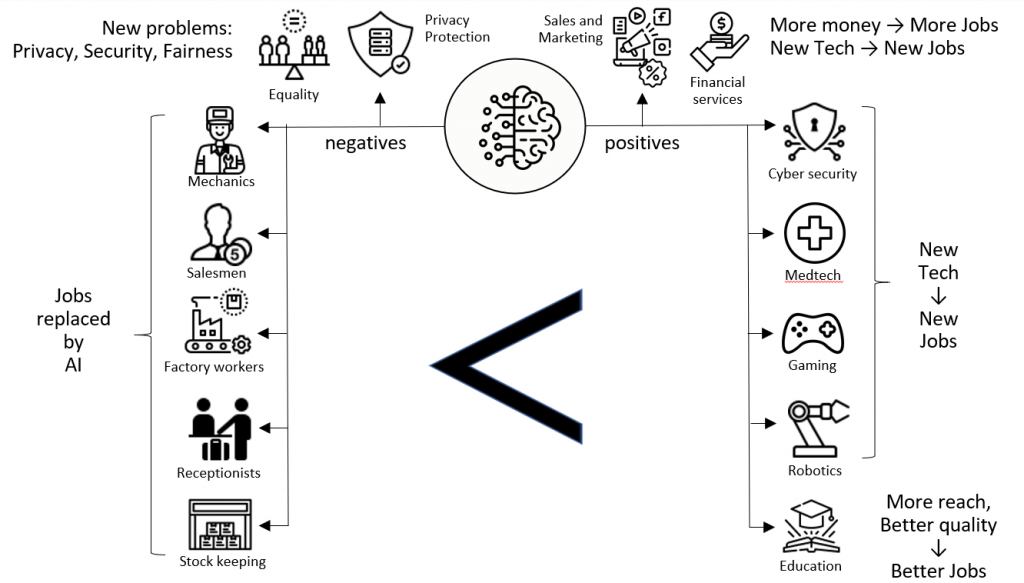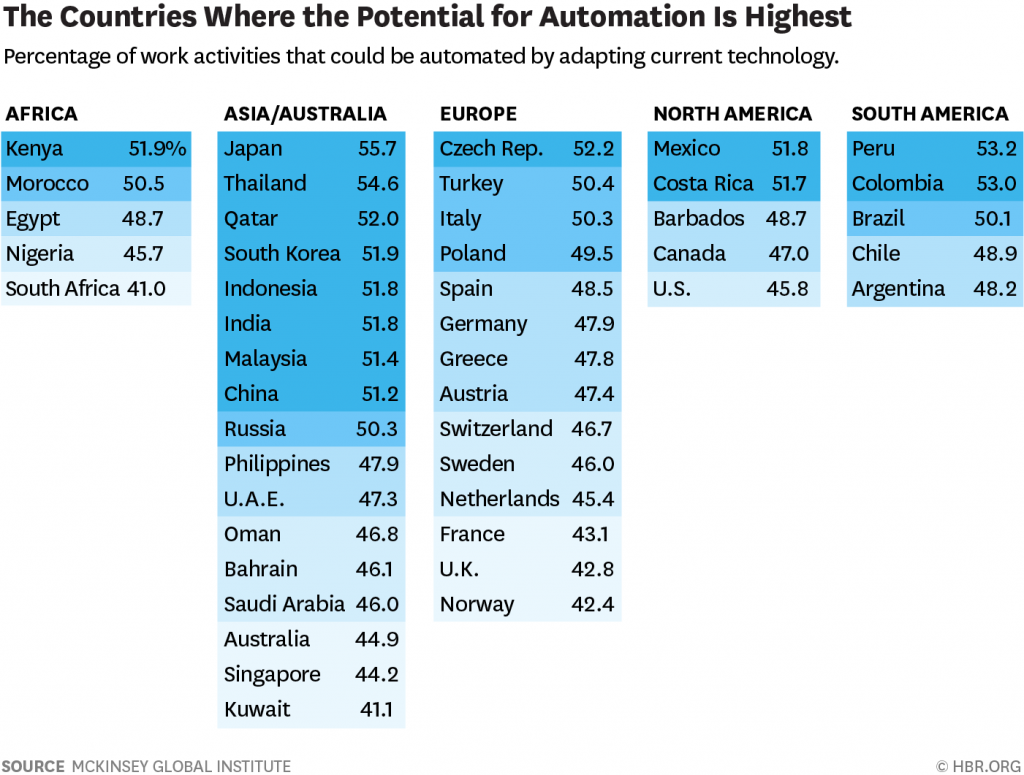Humans in the 21st century have witnessed the advent of the most revolutionary technologies ever. The prominent result of these technologies is digital transformation. The driving factor of digital transformation is undoubtedly Artificial intelligence (AI) and improved hardware. The digital transformation powered by AI has led to the usage of machines in not just automation work, but also analysis and decision-making. Now, as the growth of AI is pacing at an incredible speed, it has led to widespread panic in people as their jobs might be replaced by AI. Although the current AI is powerful, it has not yet reached the level of human intelligence. While AI is fundamentally altering how work is done and who does it, the technology’s greater impact is complementing and augmenting human capabilities rather than replacing them. Thus, AI is opening up new avenues in multiple sectors and leading to job growth in the long run.
Predictions about the impact of AI on the job market
Numerous studies and surveys have been conducted to estimate the number of jobs predicted to be displaced by AI and machines. Fears about the loss of jobs due to automation surged in 2013, when Carl Benedikt Frey and Michael Osborne, two Oxford University researchers estimated about 47% of American jobs could be lost to automation. Their report was cited widely, even in official White House reports. This led to a surge of articles that prophesied widespread unemployment and caused panic.
Job-grabbing robots are no longer science fiction, but will soon be a reality. According to analysis firm Oxford Economics, up to 20 million manufacturing jobs will be lost to robots by 2030. However, Oxford Economics provides a more nuanced view, stressing that the productivity benefits from using AI, should enhance job growth, ultimately leading to an equal number of jobs lost and generated.
On the other hand, other reports provide a more positive take. For instance, the World Economic Forum has estimated that globally about 75 million jobs will be lost to AI and automation by the end of the current year. However, they claim that upwards of 133 million new jobs will be created by AI worldwide. Similarly, Gartner, one of the world’s leading information technology research and advisory companies, predicts that two million new jobs will be created as part of AI-related job creation by 2025. As per Gartner, from 2020 onwards, AI creates more employment opportunities than it eliminates.

However, it is also important to note that even the most realistic estimates of job losses due to AI and automation rely on a lattice of interconnected predictions which may or may not come true. For example, five years ago, it appeared that robot taxis and freight trucks were on the verge of becoming commonplace. Today, we’re stuck on the verge. It can take a long time to get from “nearly good enough” to “good enough”. Therefore, it is crucial to consider all these predictions with a grain of salt.
Jobs that will be lost to AI
According to a report by PricewaterhouseCoopers, the jobs having the highest risk of being taken over by AI are transportation and storage, manufacturing, construction, public administration, accommodation and food service, and communication.

Many companies now use AI to handle customer service rather than having a dedicated human customer service agent. Chatbots are increasingly relied on to be the first point of interaction with customers. In the future, it is predicted that most, if not all of the customer chat service will be done by AI and customers.
Another job at risk of losing out to AI is the job of receptionists. Auto check-ins have replaced human receptionists in many small and large-scale hotels. Nowadays, most major restaurant chains have a communication screen, through which the customer can order their food. AI can easily handle ordering and other related tasks with ease. This has made the receptionist job almost obsolete.
Notably, manufacturing remains one of the sectors in which most human jobs are expected to be lost. While the production process for most commodities produced today has already been automated and mechanized, AI can also handle the operational aspect. AI can handle the repetitive work involved in manufacturing with ease while remaining cost-efficient.
Many jobs are expected to be lost in the transportation sector, with some estimates pointing as high as 83% potential risk for automation. Self-driving cars are already being implemented in developed countries and in the very near future, fully autonomous driving vehicles could be the norm. According to the Los Angeles Times, 1.7 million American truck drivers are expected to be replaced by self-driving cars over the next ten years.
Finally, AI has made substantial advancements in the fields of physical security and the military. There is an approximately 84% risk of physical security being replaced by AI drones and other related technology. For example, the security robot by Yelp can inspect any buildings and detect suspicious activity. Similarly, there is a high chance that future warfare could be done completely with the use of autonomous drones. Robots are used extensively in military operations such as surveillance and intelligence gathering. UK Defence Chief posits that robot soldiers could make up a quarter of the British army by 2030.
Jobs that will be created by AI
AI is more likely to change jobs than to destroy them. AI’s larger impact will be in augmenting and complementing human capabilities. Combining AI’s strengths such as scalability, speed, and accuracy of computation, and human strengths like empathy, social skills, and judgment will be the way forward.
Firstly, the demand for augmented human-machine hybrid teams has risen by a considerable amount these past years. These hybrid teams incorporate both AI’s and human’s individual strengths and blend them to generate better business outcomes. In 2019, Accenture estimated that AI-human collaboration has resulted in a 10% increase in employment opportunities.

http://www3.weforum.org/docs/WEF_Jobs_of_Tomorrow_2020.pdf
Another job created as part of the growing AI boom is the maintenance job. Demand for AI maintenance workforce will soar as AI keeps on getting implemented in every industry. Companies would need to hire many employees to maintain AI systems and ensure the system meets expectations. There would also be job openings to ensure the fairness and transparency of these AI systems.
Furthermore, human trainers are required to teach AI systems how to perform. For instance, trainers help in language translation and other natural language processing (NLP) tasks. They can prove useful in helping AI to mimic human behavior. Consider the example of customer service chatbots. Trainers could help chatbots recognize sarcasm. Moreover, trainers could teach AI to show more compassion when responding. Most AI find it difficult to detect sarcasm or show empathy while responding and this is where humans triumph.
Yet another sector where there is a massive potential for job creation as part of AI is in the entertainment industry. Streaming services such as Netflix, Amazon Prime, and Spotify already are using AI extensively in their business models. For example, by studying user choices and online behavior, AI can provide excellent movie/song recommendations according to the customer’s preferences. Therefore, a huge AI workforce is required to handle the requirements and demands of the entertainment industry.
Finally, another sector poised to reap the benefits from the impending AI boom in the education sector. The education sector is shifting rapidly to online e-learning, due to the ongoing COVID-19 pandemic. PwC’s recent report speculates that the education sector will get 200,000 extra jobs as part of this shift. According to eSchool reports, the use of AI in the education sector grew by 47.5% in the last 4 years. For facilitating such growth in the forthcoming years, plenty of AI and machine learning experts need to be hired.
Additional positives and negatives of AI
In addition to job loss and job creation, AI has a few other positives and negatives that impact the whole job market.
Firstly, AI has improved the effectiveness and reach of marketing strategies/campaigns through its efficient decision-making and analysis capabilities. Secondly, it is helping in stock management and deciding the best discount rates. Thirdly, it has enabled companies to provide better financial services with increased optimization. All these three aspects directly result in giving increased profits to the company implementing AI. Having more profits allows companies to expand and thereby increasing jobs.
Especially, after the start of the covid-19 pandemic, the need for online education has increased. Now, by exploiting AI we have optimized the transmission of live video. This is allowing people access to high-quality education from every corner of the world. Better education helps people to get placed in better jobs. This also enables people to quickly learn and adapt to new technologies or job roles. Overall, it, in turn, stabilizes and strengthens the job market.
Apart from the positives, AI also brings new problems such as privacy, security, and fairness. All these aspects are very fragile. If anything goes wrong in these, it can result in huge losses in the market, improper use of data, or unintended injustice. Though these seem to be demerits of AI, to keep them in control we need people to monitor every situation. Thus, new jobs are created to do so.

The scenario is not the same in every country
The job market scenario/statistics presented in the above sections are by analyzing the overall situation of the world. Clearly, we know that not all countries are the same. Countries such as South Korea, Japan, and Germany are effectively leveraging AI capabilities. On other hand, many countries are not. It is time that these countries must realize that AI is the only future ahead and start adapting to it to compete against the global competition.

But, why is not every nation completely exploiting AI? The important factors to be considered here are the margin of development that is possible and the capability of development. The margin development mainly depends on the number of activities that can be automated. For example, if a country is fully dependent on mining activity (not even has refineries) then there is very little scope for automation; hence less use of AI. The capability development majorly depends on the capital investment and the educational levels of the people in the country.

Conclusion
Upon comparing the positive and negative impacts of AI on the job market, clearly, the positives over weigh the negatives. Though this view seems contrarian, the latest statistics released on the effect of AI jobs support the our argument. Thus, while it is true that many jobs will be or being replaced by AI machines that outperform human efficiency, it is also important to note that AI will lead to long-term growth in number of jobs. Finally, AI-human collaboration builds a prosperous future.
As the replacement of humans by AI is inevitable and for a better future, governments and companies should undertake adaption policies and help the people replaced by AI. People should up-skill and re-skill themselves if necessary to cope with increasing usage of AI technologies. Hence, education plays a vital role in sustaining during this change. On the other hand, to preserve traditional aspects such as handicrafts, government should encourage people to support (buy) them.


